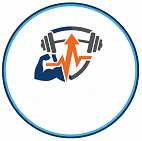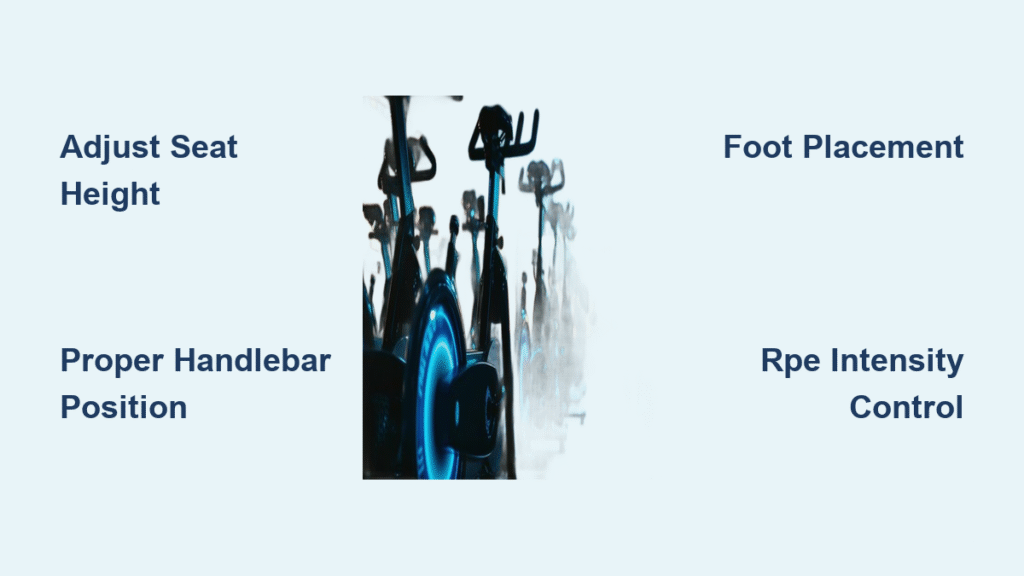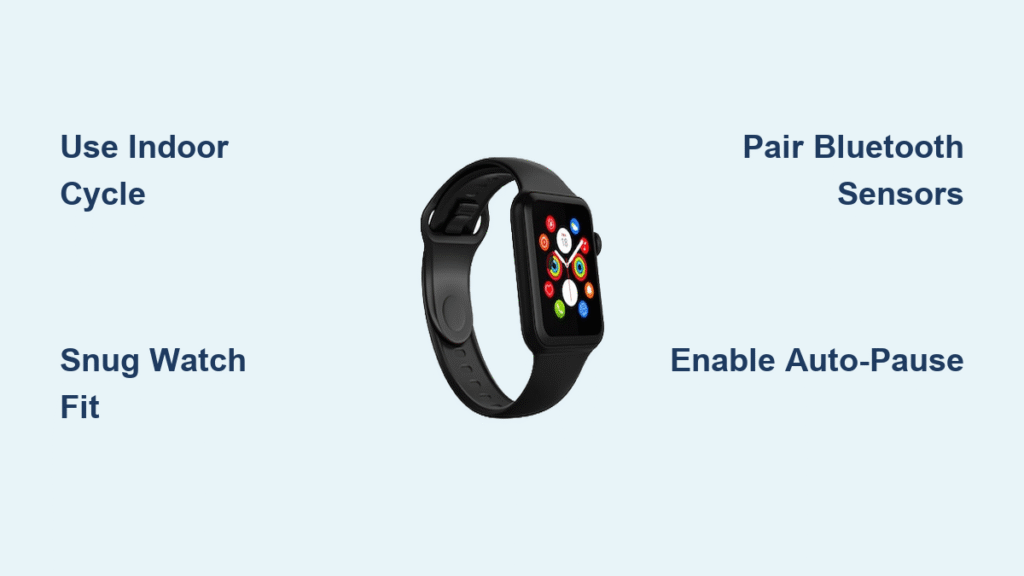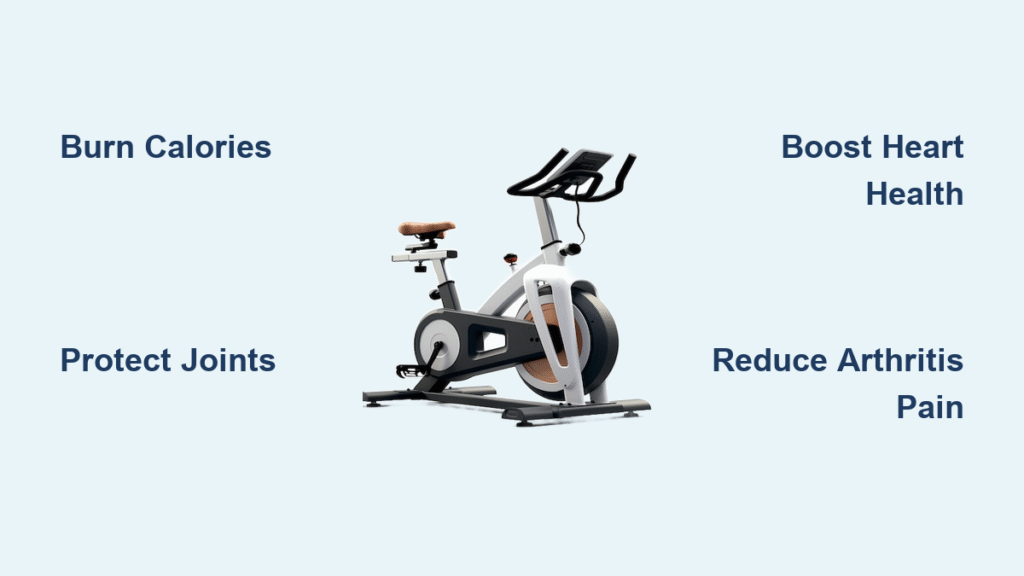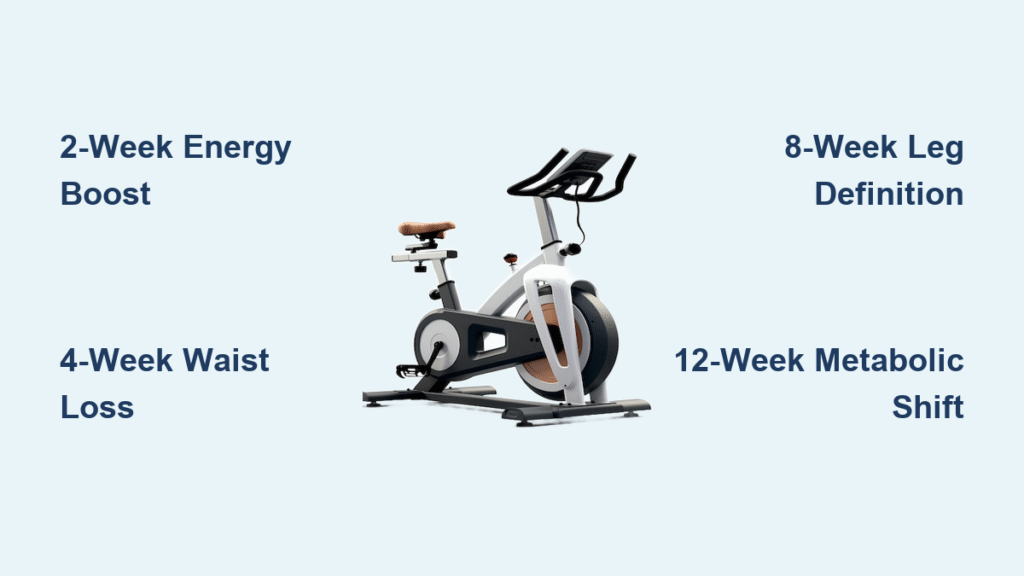Spin bike exercise for beginners delivers serious cardiovascular benefits with minimal joint stress, making it perfect for those starting their fitness journey. Whether you’re recovering from injury, avoiding harsh weather, or seeking a controlled workout environment, spin bikes transform home fitness with professional results minus the punishment. This guide eliminates confusion with precise setup instructions and a proven 20-minute protocol that delivers results from your very first ride.
You’ll master proper bike configuration, learn three essential riding positions, and follow a scientifically-backed workout structure that builds endurance without burnout. No more wondering if you’re doing it “right”—these actionable steps create immediate confidence while protecting your knees and joints during this low-impact cardio powerhouse.
Perfect Your Spin Bike Setup in Under 5 Minutes

Adjust Seat Height to Prevent Knee Pain
Stand next to your bike and raise the seat until it aligns with your hip bone. When seated, your knee should maintain a 25-30 degree bend at the bottom of each pedal stroke—never locking straight. This slight flex protects your knee joints while maximizing power transfer. Warning: A seat set too high causes hip rocking and Achilles strain, while a seat too low creates unnecessary knee pressure during every rotation.
Position Handlebars for Spine Safety
Begin with handlebars set at or slightly above seat height to reduce lower back strain while you build core strength. Reach the bars with relaxed shoulders and elbows slightly bent—not locked straight. As you progress over weeks, gradually lower the handlebars to increase core engagement. Your spine should maintain its natural curve without rounding or overextending during seated efforts.
Secure Feet for Maximum Power Transfer
Place the ball of your foot directly over the pedal spindle—not the arch or heel—and tighten straps snugly but without cutting off circulation. Proper foot placement prevents Achilles tendon strain and ensures efficient power delivery through your entire pedal stroke. Pro tip: Practice “ankle circles” during warm-ups to maintain flexibility and prevent foot numbness during longer sessions.
Master Three Essential Riding Positions
Seated Foundation: Your Default Starting Point
This seated position with hands on handlebar tops forms your baseline for warm-ups, recovery periods, and steady efforts. Maintain 80-100 RPM cadence while focusing on smooth pedal circles—push down, scrape back, pull up, kick forward. You should feel comfortable enough to speak in short sentences. This position protects your joints while building cardiovascular endurance with minimal impact.
Standing Jog: Build Strength Without Strain
Rise slightly from the saddle, keeping hips just above the seat while hands rest on handlebar tops. Engage your core for balance as you maintain 70-90 RPM cadence. This position develops leg strength while reducing saddle pressure. Common mistake: Beginners often lock their elbows, transferring vibration to their shoulders—keep arms relaxed with a slight bend at the elbows for shock absorption.
Power Climb: Conquer Simulated Hills
Reach forward to handlebar ends, hinge at hips, and stand tall with resistance increased. Your body forms a straight line from head to hips at 40-50 RPM, demanding serious core stability. This aggressive stance builds power for challenging climbs. Expert note: If your hips sway side-to-side, reduce resistance immediately—proper form trumps heavy resistance every time.
Decode Your Workout Intensity Like a Pro

Rate Effort Using the 1-10 Scale
Use this simple RPE (Rate of Perceived Exertion) scale to gauge intensity:
– 1-2: Barely moving, full conversation possible
– 3-4: Comfortable pace, easy talking
– 5-6: Challenging but sustainable effort
– 7-8: Hard work, limited talking
– 9-10: Maximum effort, gasping for air
Your first sessions should stay between RPE 4-6—challenging but manageable. Pushing too hard too soon causes burnout and discouragement.
Match Cadence to Your Goals
Different RPM ranges target specific adaptations:
– Warm-up/recovery: 80-90 RPM (light resistance)
– Moderate endurance: 85-100 RPM
– Speed development: 100-125 RPM (light resistance)
– Strength building: 40-50 RPM (heavy resistance)
Beginners often spin too fast with too little resistance—aim for “pushback” against each pedal stroke without bouncing in the saddle.
Your First 20-Minute Beginner Ride
Minutes 1-5: Movement Preparation
Start with light resistance at 80 RPM, focusing on smooth pedal circles—not exercise yet, but movement preparation. Breathe naturally through your nose and mouth. This establishes neuromuscular patterns before adding intensity. Visual cue: Your legs should move in quiet, fluid circles without jerking motions.
Minutes 5-8: Establish Your Baseline
Increase resistance slightly until you reach RPE 5—you could talk, but prefer not to. Maintain 85 RPM while feeling your legs engage deliberately. This moderate effort builds cardiovascular capacity without overwhelming beginners. Pro tip: Set a timer for each segment to avoid checking the clock constantly.
Minutes 8-10: First Challenge Interval
Add one more resistance increment, nudging to RPE 6. Your breathing deepens but remains controlled—this is your “working” pace. Focus on maintaining form as intensity increases. Warning: If you’re bouncing in the saddle, reduce resistance immediately—proper form prevents injury.
Minutes 10-13: Active Recovery
Return to baseline resistance while continuing to pedal. This teaches your body to process recovery efficiently while maintaining blood flow. Your heart rate begins dropping but legs stay warm for the next effort. Expert note: Recovery segments are where fitness adaptations accelerate—don’t skip them.
Minutes 13-20: Build Confidence
Repeat the challenge-recovery pattern, then gradually reduce resistance during the final 5 minutes. Notice how your second effort feels more manageable—this demonstrates your body’s rapid adaptation. Finish with gentle leg swings off the bike to maintain flexibility.
Avoid These 3 Beginner Mistakes
Resistance Roulette
Too little resistance causes inefficient bouncing and wasted effort. Too much creates grinding, jerky movements that strain joints. Find the middle ground where legs work smoothly against consistent pressure. Fix: Increase resistance one notch at a time, testing each increment before adding more.
White-Knuckle Grip Syndrome
Gripping handlebars too tightly transfers road vibrations to your neck and shoulders. Maintain a firm but relaxed grip with slightly bent elbows. Your hands should rest lightly on the bars, not clamp them. Pro tip: Periodically shake out your hands during longer sessions.
Ego-Driven Pacing
Starting too hard leads to early burnout and discouragement. Begin conservatively—you can always add intensity, but you can’t take back overexertion. Rule of thumb: Your first 5 sessions should feel “too easy” at the time—you’ll appreciate this when you’re consistently showing up.
Progress Without Burnout
Complete 20-minute sessions three times weekly for weeks 1-2, focusing on technique over intensity. Your goal: finish energized, not exhausted. After two weeks, add 5 minutes per session while maintaining intensity ratios. Critical insight: Consistency beats intensity—three moderate sessions weekly outperform one “killer” workout.
By month two, introduce simple intervals like 2 minutes hard/2 minutes easy. Track weekly mileage goals: beginners target 5-7 miles in 30 minutes at moderate resistance. Monitor your two-minute recovery heart rate—your pulse should drop 20+ beats after stopping. Slower recovery signals overtraining.
Maintain Your Equipment Weekly
Wipe down your bike after each session—sweat corrodes metal parts within weeks. Check pedal straps for fraying and seat adjustments for security. A two-minute post-ride routine prevents major repairs. Monthly, test resistance adjustments for smooth operation and lubricate the chain if your bike uses one. Pro tip: Keep a microfiber towel and water bottle beside your bike for immediate post-ride cleaning.
Scale Your Training Safely
Start with three sessions weekly. After 4-6 weeks of consistent training, increase to 4-5 sessions if desired. Include at least one complete rest day weekly—your body improves during recovery, not just during work. Balance cycling with complementary activities like strength training for muscle balance and yoga for flexibility.
Listen to your body: Persistent knee pain, unusual fatigue, or declining performance signals overtraining. Scale back immediately and reassess. Progress isn’t linear—expect occasional setbacks and adjust accordingly.
Your spin bike journey begins with a single pedal stroke. Focus on consistency over intensity during your first month—master these basics before chasing advanced workouts. The rider who shows up three times weekly for moderate efforts outperforms the weekend warrior who occasionally crushes themselves.
Remember: every expert cyclist started exactly where you are now. Start simple, progress gradually, and let your body’s adaptation guide your advancement. After 4-6 weeks of consistent training, explore interval protocols—but for now, commit to three 20-minute sessions this week. Your future fitness self will thank you for these patient beginnings.
